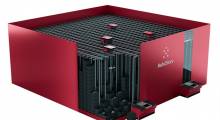Many bulk liquid suppliers and end users are seeking value-added alternatives to commonly used bulk containers that are constructed of a thin-walled, blow-molded bottle inside a light-duty metal support frame. That type of construction is only practical for temporary or one-time use, says Michael Spurrier, vice president of sales and marketing for Snyder Industries.
“Customers want more durable liquid handling containers that can be returned and reused in a closed loop, over and over, for a long period of time,” he explains. “This allows them to maximize their investment, be a steward of the environment and eliminate disposal issues.”
Selecting the right reusable liquid bulk container for a given application depends on many variables, including chemical compatibility, safety factors, corrosion resistance, material weight, handling, filling and dispensing requirements, as well as the viscosity of the liquid, Spurrier says.
To drain the contents from these containers, a slope ranging from 10 degrees to 60 degrees can be engineered into the bottom of the container’s interior. “The most common slope angle is 45 degrees as it allows higher viscosity liquids to flow freely from gravitational forces,” he says.
Thicker liquids with the consistency of caulking are often handled in containers that interface with a positive displacement pumping system. The containers feature a removable lid so a plunger can be inserted to push the contents out.
Similarly, containers holding greases or inks might employ a follower plate—a piece of metal or plastic whose edges are flush with the sidewalls—that sits on the surface of the contents. As the liquid is pumped out, the follower plate scrapes the sides to ensure the contents drain completely.
“For liquids that need to maintain a higher purity standard, the container can be equipped with special draw tubes and return connections for filtration purposes,” adds Spurrier.
Also important is the container’s specific gravity rating, which translates into the maximum weight the container can safely handle. Water’s specific gravity is 1.0, or approximately 8 pounds per gallon. “Sulfuric acid can have a specific gravity of almost 1.9—nearly double the weight of water. Knowing the limits of the container impacts its warranty, projected useful life, stack rating, and the compatibility of its construction with a particular liquid,” he says.
Read more Packaging Corner.







